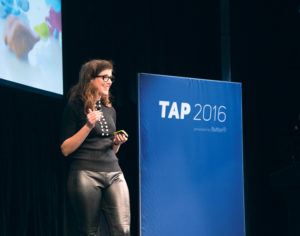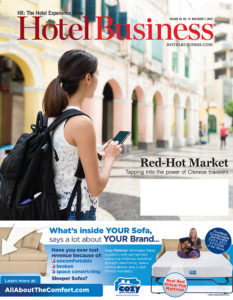NEW YORK—At TAP 2016, presented by Button, held here earlier this fall, leaders in mobile came together to discuss industry trends and innovations. And with a mobile-first strategy a must for businesses in any industry, leaders from companies such as Facebook, Pinterest and Eventbrite shared insights that hospitality companies could learn from when developing mobile solutions for the global community—and could also be helpful for hotel companies that use these platforms to engage guests.
In her keynote address, Margaret Gould Stewart, VP, product design, Facebook, said, “As a designer, I am very interested in history because I think in technology, sometimes we convince ourselves the challenges we’re facing are all new—this is the first time we’ve dealt with any of these issues—and often, it’s not. It’s a version of something humans have faced many times before, and we can help navigate the future by studying our past.”
Recognizing that Facebook has been a pioneer in bringing mobile solutions across the world, Gould Stewart shared a few lessons on how to design mobile product for a global community. First and foremost: Design for people where they are. “The U.S. is only 3% of the world population, but we dominate the tech and design conversations and standards,” she said. “Yet, most of the people we design for are all over the world. There’s a real danger of projecting our own experience of the way we live and work on the rest of the world in ways that may not be relevant to them. There’s a real opportunity to break into new markets and connect with new communities, but we’re only going to succeed if we take into account the kinds of devices, connections and context in which people are living and working.”
According to Gould Stewart, 58% of the world uses a basic feature phone—not the latest iPhone. “Designing for these devices is critical if you’re going to design for where people are,” she said, noting these users are also hyper-aware of their data usage. “These phones don’t hold much information and it’s hard to download a lot of things. Smartphone penetration is improving dramatically, but connection speeds are not. You have a whole bunch of people with phones they can’t fully utilize because of the connection speeds they have access to. As we’re building tools, we really have to tune into the local realities. In response to that, we do things like a stripped-down version of Facebook called Facebook Lite for Android. It uses tons less data, moves more quickly and the app is less than a megabyte so you can fit it on this phone. It’s most popular in places where it’s most needed—Brazil, India, Indonesia, Mexico and the Philippines. And it’s used by more than 100 million users globally. We also develop products that mimic things like video to geographies that can’t access video.” She noted that this includes a product called Slideshow, where photos can be stitched together “to bring motion to phones that don’t normally see it.”
While video is out of reach for many people globally, Lisa Manowitz, head of partnerships, East region, Pinterest, noted that video would become increasingly important in the mobile space. “We’re hugely excited about video,” she said. “When people come to Pinterest, they are looking for ideas for their everyday life. From the very beginning, video is a formula consumers have organically used on our platforms.” As such, Pinterest introduced a video player to its platform this year, but Manowitz noted it’s about more than introducing inspiring content—each video is paired with a call-to-action that makes sense for the content. “The whole purpose is to drive inspiration and then allow them to take action,” she said.
This notion that Pinterest saw what users were doing—incorporating video—and built on it, echoed Gould Stewart’s second point: Are we designing not just for people but with people? She pointed to Play-Doh, which was originally created as a wallpaper cleaner. “Play-Doh, thankfully, checked its ego at the door, and created one of the most iconic brands and one of the most inspiring materials of all times,” she said. “Sometimes, innovation is achieved through intentional, preconceived paths and, sometimes, the world takes us on a completely different path. The question is will we notice and will we have the humility to follow?

Facebook’s Margaret Gould Stewart gave advice on designing mobile products for users in underprivileged areas.
“We are not the sole designers of Facebook. Everyone who uses it is,” continued Gould Stewart. “Facebook was not invented as a fundraising platform for rare diseases, or the world’s largest photo album or the most powerful Happy Birthday engine ever created; the people of the world showed us that.” She said this is even more pronounced in the age of mobile because mobile phones are in the hands of such a diverse global group.
“There is so much intelligence outside of your company. Do you have the humility to tap into it? It’s part of the reason why APIs and third-party development are so important to companies like Facebook, Google and Twitter,” she said. “We’re not under the delusion that all of the best developers and ideas are inside our companies.”
Getting outside help was certainly important to Eventbrite as it developed its mobile offering. Tamara Mendelsohn, VP and general manager, consumer, Eventbrite, said that this past summer, the number of consumers using mobile devices passed desktops for the company. “How do we engage consumers in meaningful ways on the devices they’re spending the most time using? Let’s disrupt our business from the inside out,” she said. “You shouldn’t build products that your business needs; you should build products that your customers need and solve a real pain point.”
During this process, she said, Eventbrite realized three lessons. First, there is no replacement for observation. “When you build new products, customer empathy has to be at the foundation of everything you do. The way to build customer understanding is through observation.” The company held a number of focus groups across the country and not only listened but observed how the participants used mobile devices and interacted with different apps.
They also had people fill out diaries. Echoing a thought that’s true for the hospitality industry as well, Mendelsohn said, “It’s really hard to observe people at the moment they decide to go to an event, so we asked people to keep diaries, and record what was their inspiration of when they decided to do something.”
The second lesson, she said, was once you understand who the user is, get crystal clear on their needs, and the third: test and learn without emotion. Over a seven-week period, Eventbrite went through many iterations of its new app. For six days, the team would design and build a prototype, and on the seventh day, users tested the prototype. Then the process was repeated. Even now, the company has a live app in the app store, but Mendelsohn said, “It’s not perfect and that’s the point. Every two weeks we launch a new version and we’re constantly testing it to see if we’re missing the mark and where, and how we can drive engagement with our users.
“Something about that speed allows you to build without emotion,” she said. “If you spend a year building a product and put it in front of a user and they don’t like it, it’s going to be really hard to let it go… What’s become clear to me is consumer needs are getting more and more capable to predict, especially when it comes to mobile. Because mobile technology and devices are changing so quickly, it makes it very difficult to enter into really long product cycles because by the time you have something, chances are, things have changed. Mobile platforms and technology allow for this really rapid innovation.”
One new innovation that Manowitz is excited about is a new approach to search when it comes to aspirational content. “Pinterest is about discovery, and discovery can take on a number of different ideas. The way for search doesn’t have to take the form of keywords. Because we are a visual platform, search is done in a number of ways,” she said. For instance, users can focus in on a part of a photo—if the user is looking at an outfit, but only likes the shoes, the user can highlight that. Similarly, if a user sees someone walking on the street, they can take a picture and be able to find those shoes on Pinterest. “How do you connect discovery in the real world?” she asked, noting this type of search could be realized across interests.
Gould Stewart noted that one last thing companies should remember—particularly when it comes to advertising—is this: Are we designing with respect for everyone? “In so many dystopian novels and films, advertising plays a disturbing role. It’s this horrifying future that film and writers are envisioning; invading every crevice of our lives,” she said. “Is this really inevitable? Instead of unbridled access, what if technology empowered people to design their own experiences and let them control the experiences they want to have?”
She said, “What would we need to do to be on the winning side of that scenario? Be seen as a partner of the people of the world and empowering them to use technology instead of feeling enslaved by it.” Gould Stewart noted that this is why Facebook introduced Ad Preferences, where users can see the keywords that have triggered the ads they receive and can choose to remove those keywords to keep from seeing ads they dislike. This, of course, will be important for the strategy of any company that advertises on Facebook, but it also is something to keep in mind as access to data and information about people becomes more readily available and companies build up their guest profiles.
“Consumers are increasingly empowered. They have expectations of their own and expect value, transparency, control. They deserve it. They want it… It’s a powerful ability we’re giving people to say this is what I want and what I don’t want,” Gould Stewart concluded. HB

